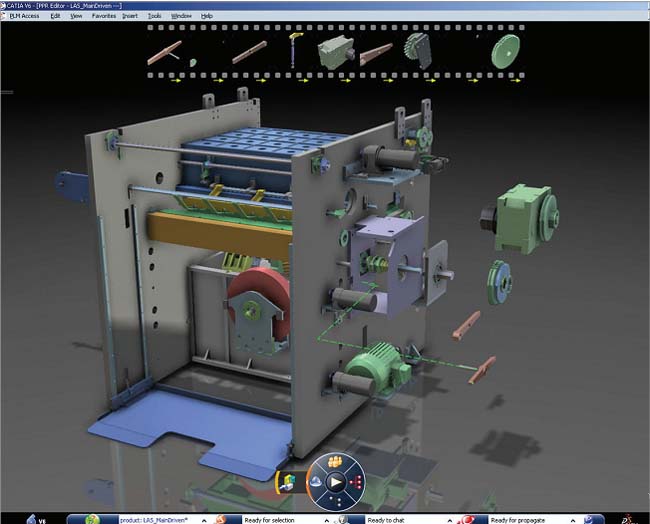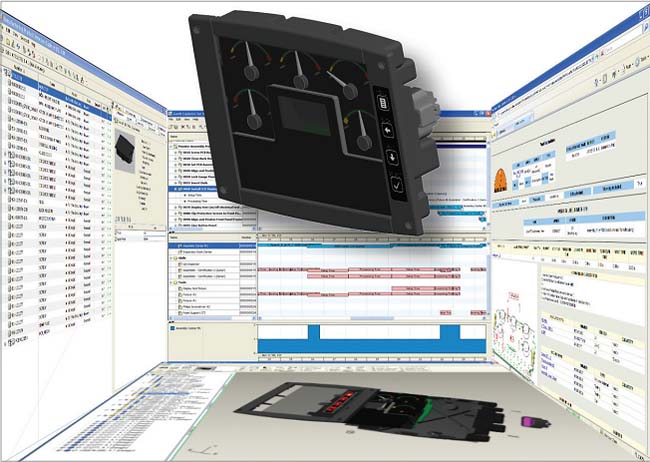Reconnecting Design & Manufacturing
By formally restructuring and enabling the symbiotic relationship between design and manufacturing, manufacturing process management tools enhance productivity.
Latest News
June 1, 2010
By Tom Kevan
The universe of product lifecycle management (PLM) continues to expand and incorporate more phases of the lifecycle as interdependencies and mutually beneficial interactions dictate. The concurrence of design and manufacturing is proving to be an area in which enhanced collaboration can deliver greater innovation, productivity, and competitiveness in product development.
 Figure 1: MPM process simulation enables engineers to optimize the assembly manufacturing plant/cell layouts using 3D tools. The software lets the engineer work with the spatial organization and components of the plant to plan the downstream evolution of the shop floor layout. (Image courtesy of Dassault Systèmes Delmia Corp) |
In a parallel trend, traditional approaches to managing manufacturing processes increasingly fail to reduce costs and improve productivity. As a result, companies need a different approach that will help them survive and excel in a marketplace that is increasingly unforgiving in terms of development costs and product delivery schedules.
The answer to both trends is the rise of a set of tools within the PLM suite that bind design and manufacturing more closely together. The payoff from this migration is significant. To see its true value, you only have to follow the data trail.
Managing Manufacturing Processes
The toolset in question is known by many names, including Manufacturing Process Management (MPM), Digital Manufacturing, and Collaborative Manufacturing Process Management. Nomenclature aside, a good definition of the approach can be found in the CIMdata white paper titled “Digital Manufacturing in PLM Environments.” The PLM consulting firm says that when manufacturing process management is combined with PLM’s data management and CAD capabilities, the resulting toolset integrates the definitions of products, processes, practices, plants, tools, and resources into a consistent manufacturing system. Integrating product design and manufacturing provides a system that supports processes from concept to disposal.
“In digital manufacturing, we are looking at the definition of the product and configuration management,” says Peter Schmitt, Vice President of business development for Dassault Systèmes’ DELMIA. “We are articulating the sequence, dependencies, and precedents of the processes. We define a schematic layout on how and where those processes can be executed (see Figure 1). We further describe those processes from assembly simulation to time measurement. We define robotic, manufacturing, quality, and inspection processes. We describe the layout of the factory, lines, and cells, where the product is manufactured or assembled. We look at the material flow and the creation of programs for robots, PLCs, controllers, and master control machines that are downloaded to the shop floor.”
A Single Source of Data
Engineers started in the CAD arena, and they were generally concerned with products. They needed a place to manage their revisions and configurations of product data. The natural progression was for them to adopt product data management (PDM). With it, they could manage the workflow associated with the multiple groups in design engineering responsible for different functional areas of a particular product.
PDM has become the core of PLM, which derives its importance from the interactions of all the phases in its environment (e.g., design, manufacturing, maintenance). PLM’s core value is the fact that it is the single source of the highest quality product data, upon which everything in the lifecycle depends. Having all the areas of PLM draw from and align their data with this single source ensures the accuracy and consistency required to compete and survive in the marketplace.
 Figure 2: MPM enables concurrent product and manufacturing process definition. (Image courtesy of PTC) |
MPM is a part of PLM, and it is natural to start migrating process data into the mix. The hope is to give design engineers access to this data so they can determine why products come back with requests for changes. There is a need for increased collaboration not only among the manufacturing engineers but also with the design engineers.
“The single source contains more than the MPM,” says Tom Hoffman, a director of Tecnomatix for Siemens PLM Software. “The single source is really the core for everything. MPM happens to be a layer that is tied to that single source of data. Manufacturing process management bridges the gap and ties product data to process data. So you are looking at product, process, plants, and resources and the interactions among them. They are all linked to the single source of data.”
The Design-Manufacturing Connection
The link between design and manufacturing hasn’t always been recognized. All too often, what little collaboration occurred between the two has been a case of too little, too late. Overcoming the disassociation between the two phases of product development has physical and organizational obstacles.
In the past, manufacturing engineers were often not brought into the process until the design was completed. This precluded them from providing valuable input early enough in the cycle to optimize the design for manufacturing and prevent the incorporation of design elements that would diminish the effectiveness of or outright impede the production processes. Using the manufacturing process management approach, manufacturing engineers are involved early in the design cycle, when the models are being put together. This means that by the time the design is ready for production it can be efficiently manufactured and rework is nearly eliminated.
“We see manufacturing process management as the link between design and manufacturing,” says Mike Distler, director of product marketing at PTC. “In some cases, the manufacturing folks are in another building or on the other side of the world, and their connection to the design process can be difficult. This type of software can really bridge that gap. Now they are part of the overall product development process. It’s important for manufacturing to be involved at that stage and get their input upfront.”
Manufacturing process management, or digital manufacturing, formalizes the collaborative workflow between design and manufacturing. “On the design side, you define the product’s requirements—the functions the product should perform and the market requirements it should meet,” says Dassault’s Schmitt. “Based on that, you start your design and validate key features through a CAE-type analysis. Then you validate that the product can be manufactured by determining the sequence, number of people needed, and manufacturing cost. You want to make sure the processes you deploy are repeatable and can produce a quality product. At the end of the day, a good product is only a good product if it has the right qualities and manufacturing cost and is available to the customers at the right time.”
A key part of the manufacturing process management approach is the virtual build scenario, in which CAE tools are used to determine how well a design can be translated into manufacturing and assembly processes. “There have been instances where 200 to 250 issues have been found in a design that has gone through the virtual build process,” says Schmitt. “These would not have been found without the virtual build until a physical prototype was built. So this is one reason why the connection between design and manufacturing must be very close.”
Collaborative Development
The interaction between design and manufacturing, facilitated by MPM, covers the entire development process, from the early stages of the design cycle, through the feedback loop, to the change and approval process. The scale of this collaboration can be seen—again—by looking at the data trail.
Collaboration in the early stages of design combines the insight of the design team with that of the manufacturing engineers. This ensures that the design meets the functional and market requirements and is optimized for manufacturing. The result is the engineering bill of materials. The data derived from this process is used to define resources, tooling, work instructions, and staffing. This process generates the manufacturing bill of materials.
There is, however, another part of MPM. Design and manufacturing engineers not only work together early in the design phase but also during the implementation of changes later in the development cycle.
“Manufacturing process management helps when feedback on the initial design comes back from the shop floor or when design realizes it has to make a change,” says PTC’s Distler. “At this point, MPM helps by coordinating change management between design and manufacturing.”
“Design engineers have the ability to say, ‘I want to make this change. What will it affect?’ ” says Tecnomatix’ Hoffman. “Then manufacturing comes back and indicates that if the part is changed it will affect these particular plants and processes, and maybe this particular tool that holds the part. The interaction between design and manufacturing enables the group to consider the proposed change and make more intelligent decisions. It goes back to the increasing collaboration between design and manufacturing. There is no more ‘throw it over the wall.’ It is almost like the design engineer and the manufacturing engineer are sitting at workstations right next to each other.”
Many leading PLM technology providers include MPM modules in their environments that enable companies to create, validate, and optimize manufacturing processes. The idea is to leverage information interrelationships and enable collaboration among all engineering disciplines in the design and manufacturing segments.
Toolsets
Dassault Systèmes’ DELMIA Digital Manufacturing & Production software enables companies to define, plan, create, monitor, and control all processes, from early planning, assembly simulation, modeling welding lines, and robot and cell programming to the definition of the production facility and equipment. The software suite’s modules allow manufacturers to model in 3D and validate production cell setup; simulate and program robotic workcells; perform ergonomic simulation to optimize work space and worker efficiency; simulate parts and assemblies to validate manufacturing processes; and create and validate mechanical, kinematical, and logical device behavior for PLC and robot programs.
Siemens’ MPM functions are implemented by two applications: the manufacturing process planner and the parts planner. Both operate within the Teamcenter environment. The MPM functionality is enhanced with the Process Simulate and FactoryCAD programs.
Process Simulate allows manufacturers to verify the feasibility of operations through the simulation of product assembly processes. Tools such as sections, measurements, and collision detection enable detailed verification and optimization of assembly situations.
FactoryCAD allows engineers to work with “smart objects” that represent factory resources, from floor and overhead conveyors and mezzanines and cranes to material handling containers and operators. This specialized software allows manufacturers to gain insight into their factory layout and installation processes.
PTC’s Windchill MPMLink provides for the step-by-step optimization of manufacturing operations. The software enables manufacturing engineers to evaluate design requirements in relationship with the company’s manufacturing capabilities. The application allows design and manufacturing to work concurrently, early in the development cycle (see Figure 2). Together the two groups create preliminary manufacturing bills of material and process plans, initiate tooling requests, and establish time and cost estimates.
The application enables manufacturing engineers to create and compare process alternatives to determine the best way to optimize the manufacturing processes. Once the final plan is decided, manufacturing can detail and document the final manufacturing process.
More Info:
CIMdata
Contributing Editor Tom Kevan is based in New Hampshire and is DE’s mechatronics, PLM, and systems expert. Send your comments about this article to [email protected].
Subscribe to our FREE magazine, FREE email newsletters or both!
Latest News
About the Author
DE’s editors contribute news and new product announcements to Digital Engineering.
Press releases may be sent to them via [email protected].






